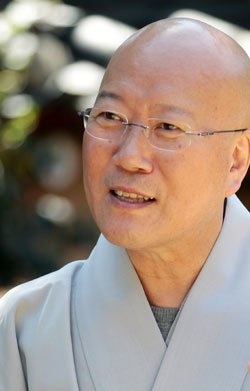ZEN MESTEREK ZEN MASTERS
« Zen főoldal
« vissza a Terebess Online nyitólapjára

수불 / 修弗 Subul (1953-)
![]()
Magoksa Temple (K = 마곡사, C = 麻谷寺). Magoksa is the head temple of the Jogye Order of Korean Buddhism, located just a few hours south of Seoul by bus/car. Master Subul, the head of the International Seon Center at Dongguk University and abbot of Beomeosa Temple, instructed our group throughout with talks and Q&A sessions. Subul believes Kanhwa Sŏn to be the most revolutionary spiritual practice in the history of mankind. It can be, he says, "made readily accessible to the public and should be. Now is the time to introduce to the world, not only Korea, the effectiveness of Kanhwa Sŏn practice. History has given a mission to us who live in this age of open information; that is to make Kanhwa Sŏn accessible to all." Subul believes that "sudden awakening" is possible. Subul also says: "Once one is awakened, there is no more backsliding." When asked about the role of Buddhist deities and the many icons enshrined at Kanhwa Sŏn temples, he replied: "They are dead skeletons in the street, yet important stepping stones for many. Once the practitioner reaches a certain level, however, they are a hindrance. There is an old Buddhist story that goes 'If you meet the Buddha on the road, kill him.' What does this mean? It means that Buddha is you, not someone you meet on the road. Your conception is wrong. Get rid of it. Kill all images and illusions and keep practicing. This story is attributed to Chinese master Línjì Yìxuán 臨濟義玄 (d. 866-7), the founder of the Línjì school of Chan Buddhism (K = Imje 임제, J = Rinzai 臨濟).
http://www.onmarkproductions.com/html/korea.html
PDF: A Bird in Flight Leaves No Trace: The Zen teachings of Huangbo with a modern commentary by Seon master Subul
Huangbo: Essentials of Transmitting the Mind-Dharma (Chuanxinfayao)
Translated by Robert E Buswell, Jr. & Seong-Uk Kim
PDF: Gradual Experiences of Sudden Enlightenment: The Varieties of Ganhwa Seon Teachings in Contemporary Korea
by Ryan Bongseok Joo
The Teachings of Songdam 송담 / 松潭 (1929-), Seongcheol 성철 / 性徹 (1912-1993), and Subul 수불 / 修弗 (b. 1953); paper delivered at the 2011, AAS conference in Honolulu, Hawaii. The three modern Korean Zen teachers discussed in this paper seem concerned with the state of the student before the awakening moment rather than after, as is common with Japanese and Chinese Zen traditions, where the student is given “checking questions” to determine the depth of their experience.
Western Buddhists, who were introduced to Korean Seon (Jp. Zen, Ch. Chan 禪) Buddhism through Seung Sahn sunim (1927-2004), might find it surprising that gong'an (Jp. kōan 公案 ) meditation practice is taught quite differently in Korea from the way Seung Sahn sunim trained his disciples in the West. For instance, Seon masters in Korea generally do not ask their student to resolve a series of different gong'an gates like the way Seung Sahn sunim did. Instead, meditating on a single gong'an is considered sufficient in itself to bring the student to full awakening. It is also not a common practice to allot one-on-one private interview (Jp. dokusan 独参 ) time with a Seon master as part of the daily training schedule in a Korean monastery; although students can certainly meet with their teacher after having a breakthrough experience or when facing a difficult internal obstacle outside the regular monastic schedule. For native Korean Buddhists, it has been an open secret that Seung Sahn sunim heavily adopted the Japanese Rinzai Zen style in his teaching of gong'an practice, which was familiar to his Western disciples, but foreign to most Korean Buddhists. In this paper, I would like to introduce the other side, the teachings of gong'an practices by contemporary Korean Seon masters in Korea, which would be familiar to Korean Buddhists, but probably new to many Western readers. I choose to focus on the teachings of three masters─Songdam sunim (b. 1929), Seongcheol sunim (1912-1993) and Subul sunim (b. 1953)─not only for their eminence and scope of influence among contemporary Korean Buddhists, but also for their range of different interpretations and approaches to the gong'an practice. Various English verbs have been used to describe the act of “investigating into,” “ruminating upon,” or “concentrating on” the critical phrase of a gong'an, called hwadu (Ch. huatou, Jp. wato 話頭). I am particularly interested in examining the precise meaning of the act of “meditating on” a hwadu according to these Korean masters. In addition, in spite of the ruling orthodoxy of “sudden enlightenment” in the Korean Seon tradition, which disparages any attempt to present the path to enlightenment in a gradual way, Korean masters, nevertheless, have expounded different stages that most practitioners experience prior to sudden awakening. I will discuss their descriptions of the pre-enlightenment experience while arguing that a student's awakening is often tested by their Seon master, not based on what happened after enlightenment, but rather based on the experience leading up to enlightenment. Lastly, I will visit the contemporary discussion of gong'an practice in the West and discuss the pitfalls of imagining a uniformity of gong'an practices largely based on the Japanese Rinzai Zen model.
http://buddhism.lib.ntu.edu.tw/BDLM/toModule.do?prefix=/search&page=/search_detail.jsp?seq=377556